Case Studies for Non-Detection of Islanding by Grid-Connected In-Parallel Photovoltaic and Electrical Energy Storage Systems Inverters
Abstract
:1. Introduction
2. Test Procedure for Islanding Detect
3. Experimental Results
3.1. Islanding Detection Test for the Individual Inverter
3.2. Islanding Detection Testing with Parallel Operation of Two Inverters
4. Conclusions
- (1)
- When two inverters by different manufacturers were operated in parallel at the same grid connection point, the inverters failed to detect islanding and supplied power continuously to the load or grid utility. Because the method and detection period for islanding detection of each manufacturer are different, detection can fail.
- (2)
- When the EESS inverter was charging with all the energy supplied by the PV inverter, islanding was detected. However, the PV inverter stopped due to an overcurrent error of the IGBT.
- (3)
- When the EESS inverter was charging with only some of the energy supplied from the PV inverter, islanding was not detected.
- (4)
- Because the EESS inverter can operate in parallel with other inverters of distributed power sources, an effective algorithm for islanding detection has to be applied in charging mode.
Author Contributions
Acknowledgments
Conflicts of Interest
References
- Cha, J.-H.; Park, K.-W.; Ahn, H.-S.; Kwon, K.-M.; Oh, J.-H.; Mahirane, P.; Kim, J.-E. Overvoltage Protection Controller Design of Distributed Generation Connected to Power Grid Considering Islanding Condition. J. Electr. Eng. Technol. 2018, 13, 599–607. [Google Scholar]
- Ito, Y.; Yang, Z.; Akagi, H. DC microgrid based distribution power generation system. In Proceedings of the 4th International Power Electronics and Motion Control Conference, IPEMC 2004, Xi’an, China, 14–16 August 2004; IEEE: Piscataway, NJ, USA, 2004; Volume 3. [Google Scholar]
- Doyle, M.T. Reviewing the impacts of distributed generation on distribution system protection. In Proceedings of the 2002 IEEE Power Engineering Society Summer Meeting, Chicago, IL, USA, 21–25 July 2002; IEEE: Piscataway, NJ, USA, 2002; Volume 1. [Google Scholar]
- Yang, H.; Lu, L.; Zhou, W. A novel optimization sizing model for hybrid solar-wind power generation system. Sol. Energy 2007, 81, 76–84. [Google Scholar] [CrossRef]
- Shin, S.S.; Oh, J.S.; Jang, S.H.; Chae, W.K.; Park, J.H.; Kim, J.E. A fault analysis on AC microgrid with distributed generation. J. Electr. Eng. Technol. 2016, 11, 1600–1609. [Google Scholar] [CrossRef]
- Guerriero, P.; Coppola, M.; Di Napoli, F.; Brando, G.; Dannier, A.; Iannuzzi, D.; Daliento, S. Three-phase PV CHB inverter for a distributed power generation system. Appl. Sci. 2016, 6, 287. [Google Scholar] [CrossRef]
- Cho, S.M.; Shin, H.S.; Park, J.H.; Kim, J.C. Distribution system reconfiguration considering customer and DG reliability cost. J. Electr. Eng. Technol. 2012, 7, 486–492. [Google Scholar] [CrossRef]
- Liu, H.; Li, D.; Liu, Y.; Dong, M.; Liu, X.; Zhang, H. Sizing Hybrid Energy Storage Systems for Distributed Power Systems under Multi-Time Scales. Appl. Sci. 2018, 8, 1453. [Google Scholar] [CrossRef]
- Blaabjerg, F.; Teodorescu, R.; Liserre, M.; Timbus, A.V. Overview of control and grid synchronization for distributed power generation systems. IEEE Trans. Ind. Electron. 2006, 53, 1398–1409. [Google Scholar] [CrossRef]
- Liserre, M.; Teodorescu, R.; Blaabjerg, F. Stability of photovoltaic and wind turbine grid-connected inverters for a large set of grid impedance values. IEEE Trans. Power Electron. 2006, 21, 263–272. [Google Scholar] [CrossRef]
- Lasseter, B. Microgrids [distributed power generation]. In Proceedings of the IEEE Power Engineering Society Winter Meeting, Columbus, OH, USA, 28 January–1 February 2001; IEEE: Piscataway, NJ, USA, 2001; Volume 1. [Google Scholar]
- Prodanovic, M.; Green, T.C. High-quality power generation through distributed control of a power park microgrid. IEEE Trans. Ind. Electron. 2006, 53, 1471–1482. [Google Scholar] [CrossRef]
- Lasseter, R.H. Microgrids and distributed generation. J. Energy Eng. 2007, 133, 144–149. [Google Scholar] [CrossRef]
- Pogaku, N.; Prodanovic, M.; Green, T.C. Modeling, analysis and testing of autonomous operation of an inverter-based microgrid. IEEE Trans. Power Electron. 2007, 22, 613–625. [Google Scholar] [CrossRef]
- Divya, K.C.; Østergaard, J. Battery energy storage technology for power systems—An overview. Electr. Power Syst. Res. 2009, 79, 511–520. [Google Scholar] [CrossRef]
- Roberts, B.; McDowall, J. Commercial successes in power storage. IEEE Power Energy Mag. 2005, 3, 24–30. [Google Scholar] [CrossRef]
- Joseph, A.; Shahidehpour, M. Battery storage systems in electric power systems. In Proceedings of the IEEE Power Engineering Society General Meeting, Montreal, QC, Canada, 18–22 June 2006; IEEE: Piscataway, NJ, USA, 2006. [Google Scholar]
- Husein, M.; Hau, V.B.; Chung, I.Y.; Chae, W.K.; Lee, H.J. Design and Dynamic Performance Analysis of a Stand-alone Microgrid—A Case Study of Gasa Island, South Korea. J. Electr. Eng. Technol. 2007, 12, 1777–1788. [Google Scholar]
- Kim, J.Y.; Jeon, J.H.; Kim, S.K.; Cho, C.; Park, J.H.; Kim, H.M.; Nam, K.Y. Cooperative control strategy of energy storage system and microsources for stabilizing the microgrid during islanded operation. IEEE Trans. Power Electron. 2010, 25, 3037–3048. [Google Scholar]
- Korea Solar and Energy Storage Market Public. Available online: http://esi.nus.edu.sg/docs/default-source/doc/korea-solar-and-energy-storage-market_public.pdf?sfv rsn=2 (accessed on 25 February 2019).
- KEA-Korea Energy Agency. Available online: http://www.energy.or.kr/renew_eng/new/standards.aspx (accessed on 25 February 2019).
- Choi, J.S.; Ko, J.S.; Chung, D.H. Development of Novel Algorithm for Anti-Islanding of Grid-Connected PV Inverter. J. Korean Inst. Illum. Electr. Install. Eng. 2011, 25, 76–86. [Google Scholar]
- Ahmad, K.N.; Selvaraj, J.; Rahim, N.A. A review of the islanding detection methods in grid-connected PV inverters. Renew. Sustain. Energy Rev. 2013, 21, 756–766. [Google Scholar] [CrossRef]
- Yu, B.; Matsui, M.; Yu, G. A review of current anti-islanding methods for photovoltaic power system. Sol. Energy 2010, 84, 745–754. [Google Scholar] [CrossRef]
- Kim, J.Y.; Kim, S.K.; Jeon, J.H. Coordinated state-of-charge control strategy for microgrid during islanded operation. In Proceedings of the 2012 3rd IEEE International Symposium on Power Electronics for Distributed Generation Systems (PEDG), Aalborg, Denmark, 25–28 June 2012; IEEE: Piscataway, NJ, USA, 2012. [Google Scholar]
- Kim, J.Y.; Kim, S.K.; Park, J.H. Contribution of an energy storage system for stabilizing a microgrid during islanded operation. J. Electr. Eng. Technol. 2009, 4, 194–200. [Google Scholar] [CrossRef]
- Verhoeven, B. Utility Aspects of Grid Connected Photovoltaic Power Systems; International Energy Agency: Paris, France, 1998. [Google Scholar]
- Chung, I.Y.; Moon, S.I. A new islanding detection method using phase-locked loop for inverter-interfaced distributed generators. J. Electr. Eng. Technol. 2007, 2, 165–171. [Google Scholar] [CrossRef]
- Zamani, R.; Hamedani-Golshan, M.E.; Haes Alhelou, H.; Siano, P.; Pota, H.R. Islanding Detection of Synchronous Distributed Generator Based on the Active and Reactive Power Control Loops. Energies 2018, 11, 2819. [Google Scholar] [CrossRef]
- Ding, X.; Crossley, P.A. Islanding detection for distributed generation. In Proceedings of the 2005 IEEE Russia Power Tech, St. Petersburg, Russia, 27–30 June 2005; IEEE: Piscataway, NJ, USA, 2005. [Google Scholar]
- Choi, S.S.; Kang, M.K.; Lee, H.D.; Nam, Y.H.; Rho, D.S. A Stable Operation Strategy in Micro-grid Systems without Diesel Generators. J. Electr. Eng. Technol. 2015, 13, 114–123. [Google Scholar]
- De Mango, F.; Liserre, M.; Dell’Aquila, A.; Pigazo, A. Overview of anti-islanding algorithms for PV systems. Part I: Passive methods. In Proceedings of the 12th international Power Electronics and Motion Control Conference, EPE-PEMC 2006, Portoroz, Slovenia, 30 August–1 September 2006; IEEE: Piscataway, NJ, USA, 2006. [Google Scholar]

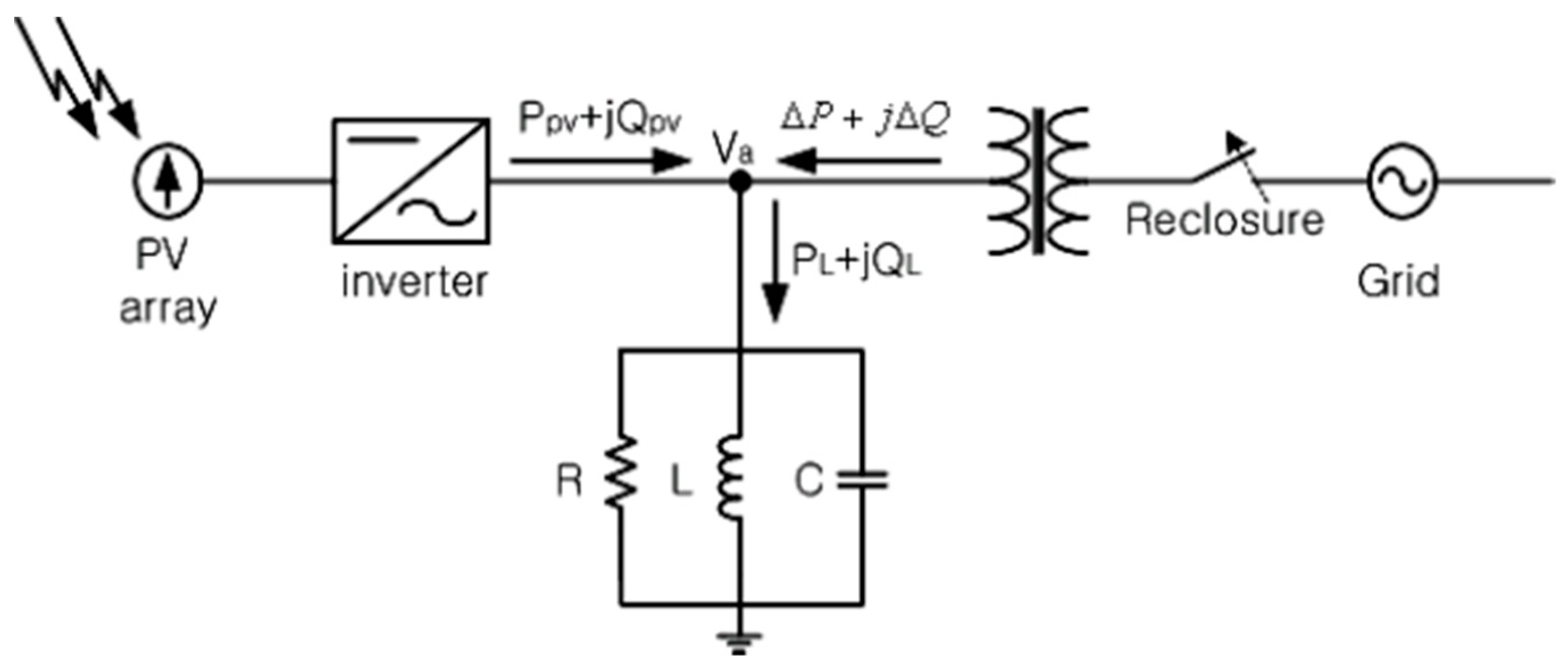
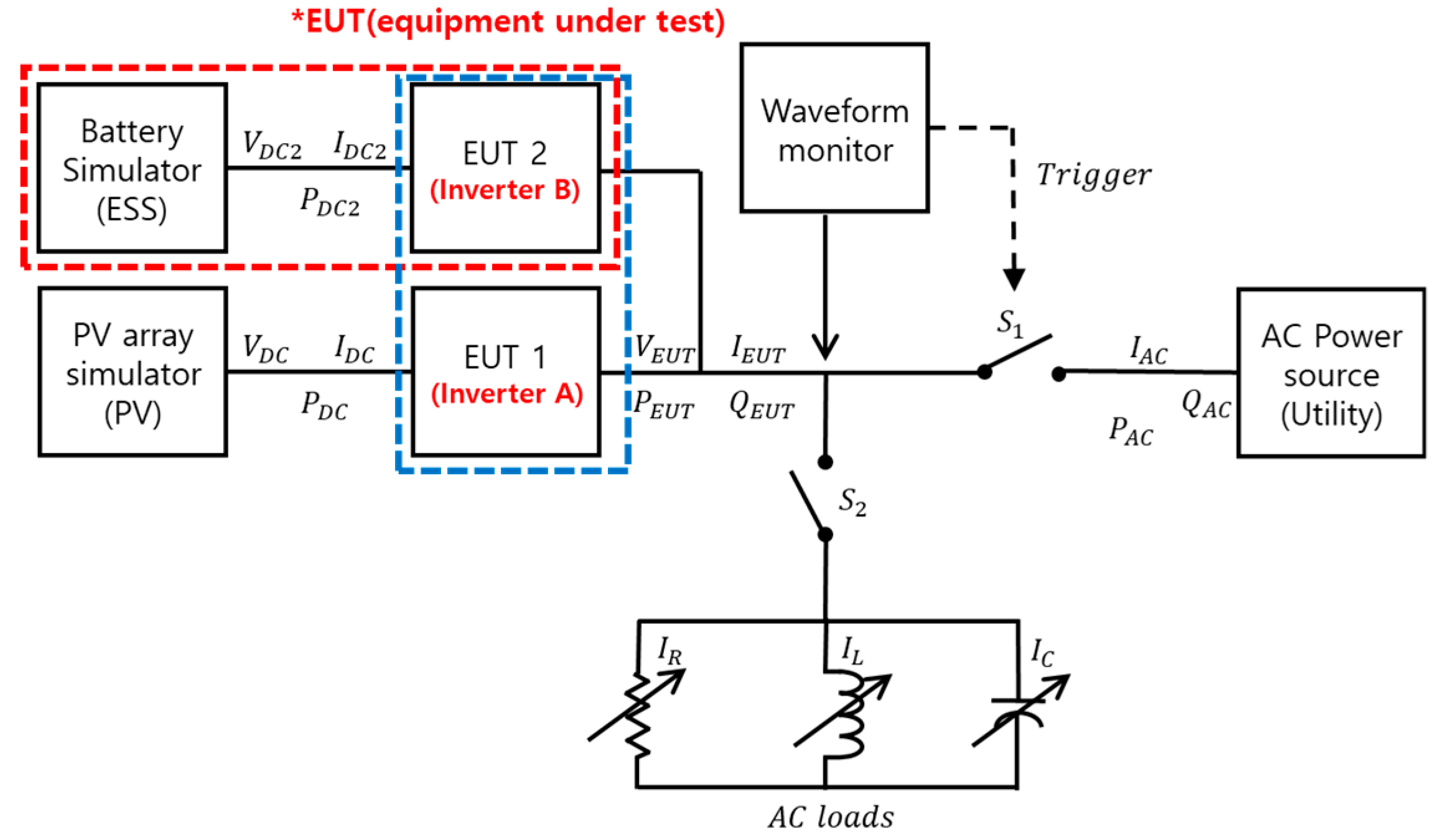
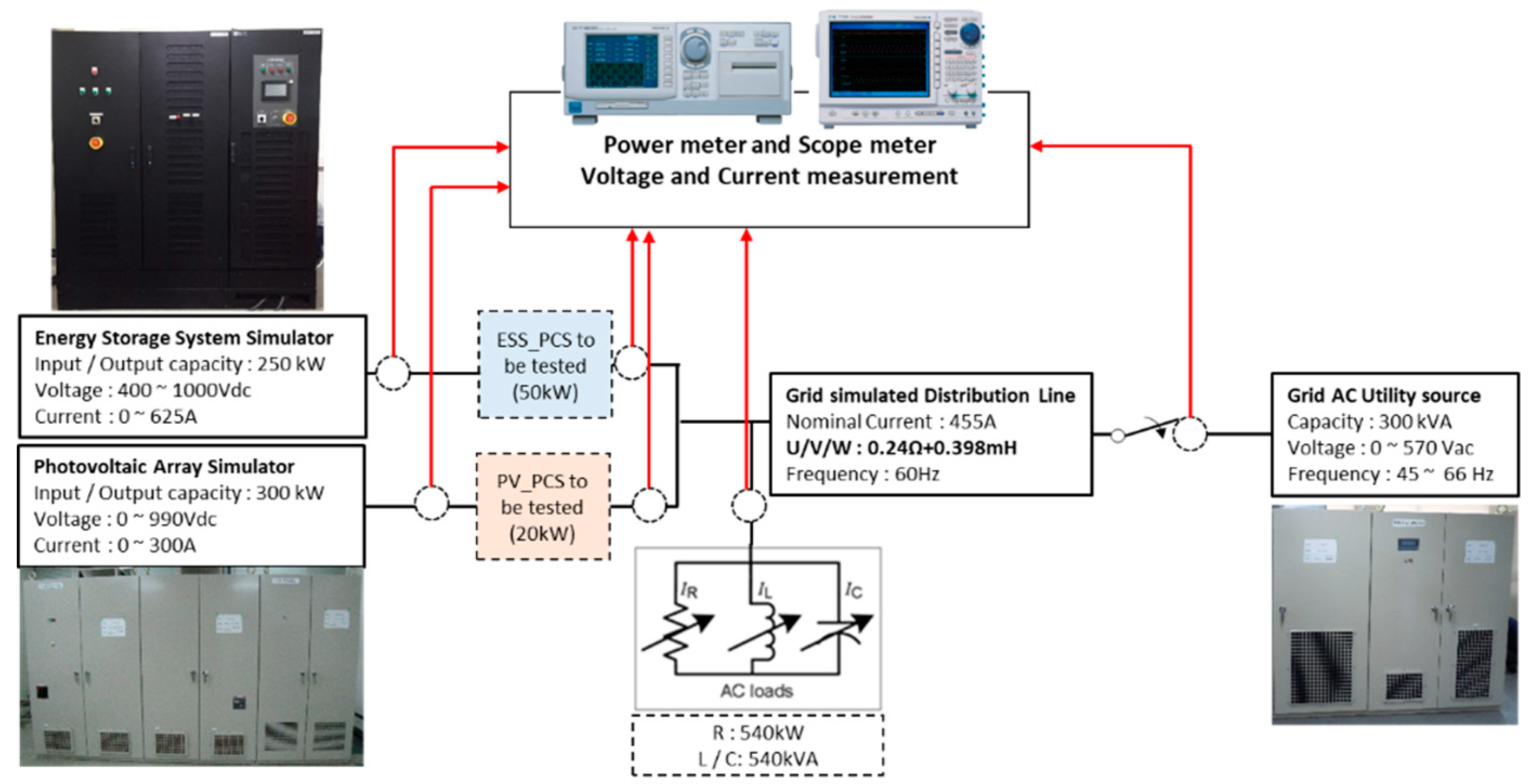
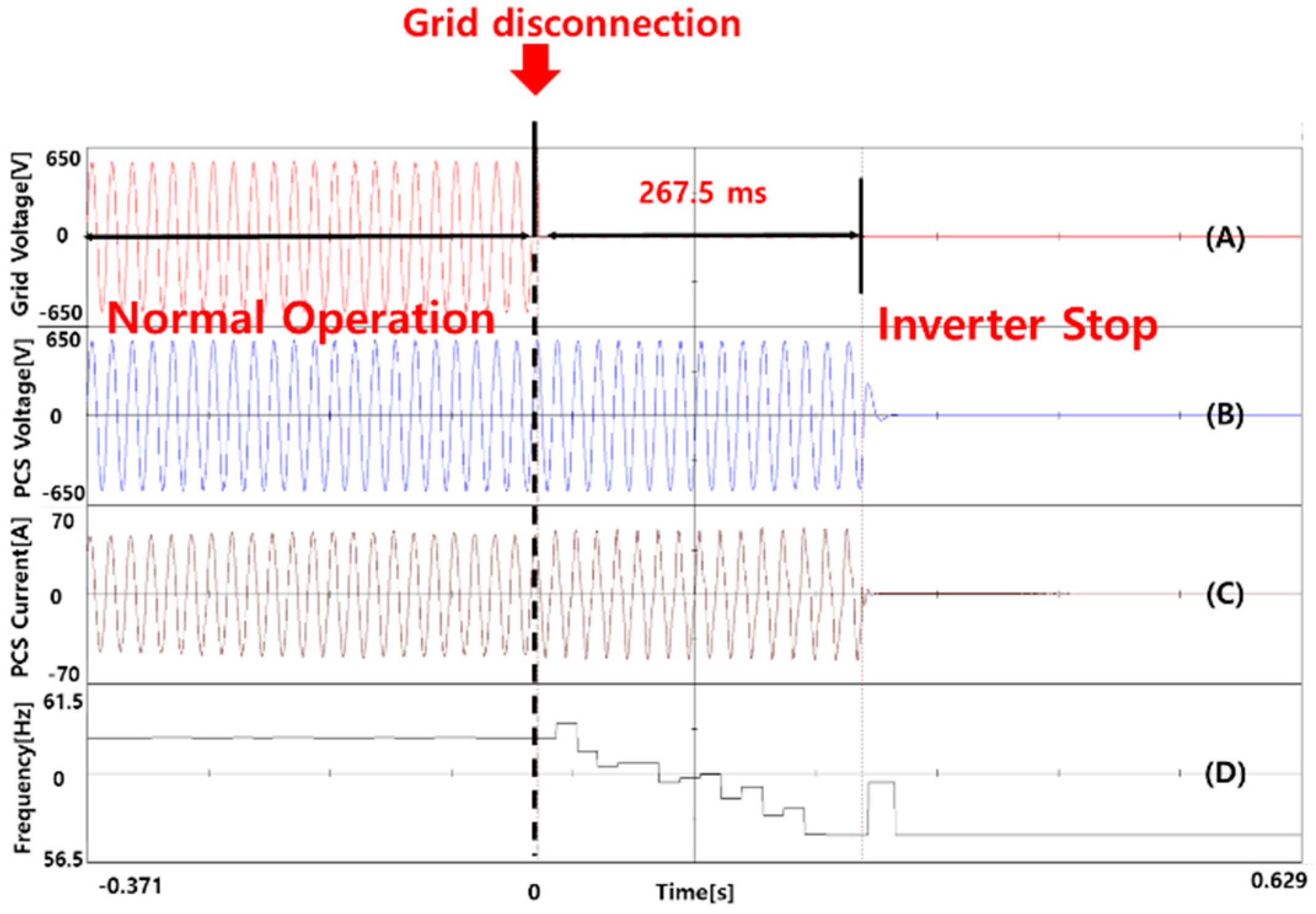
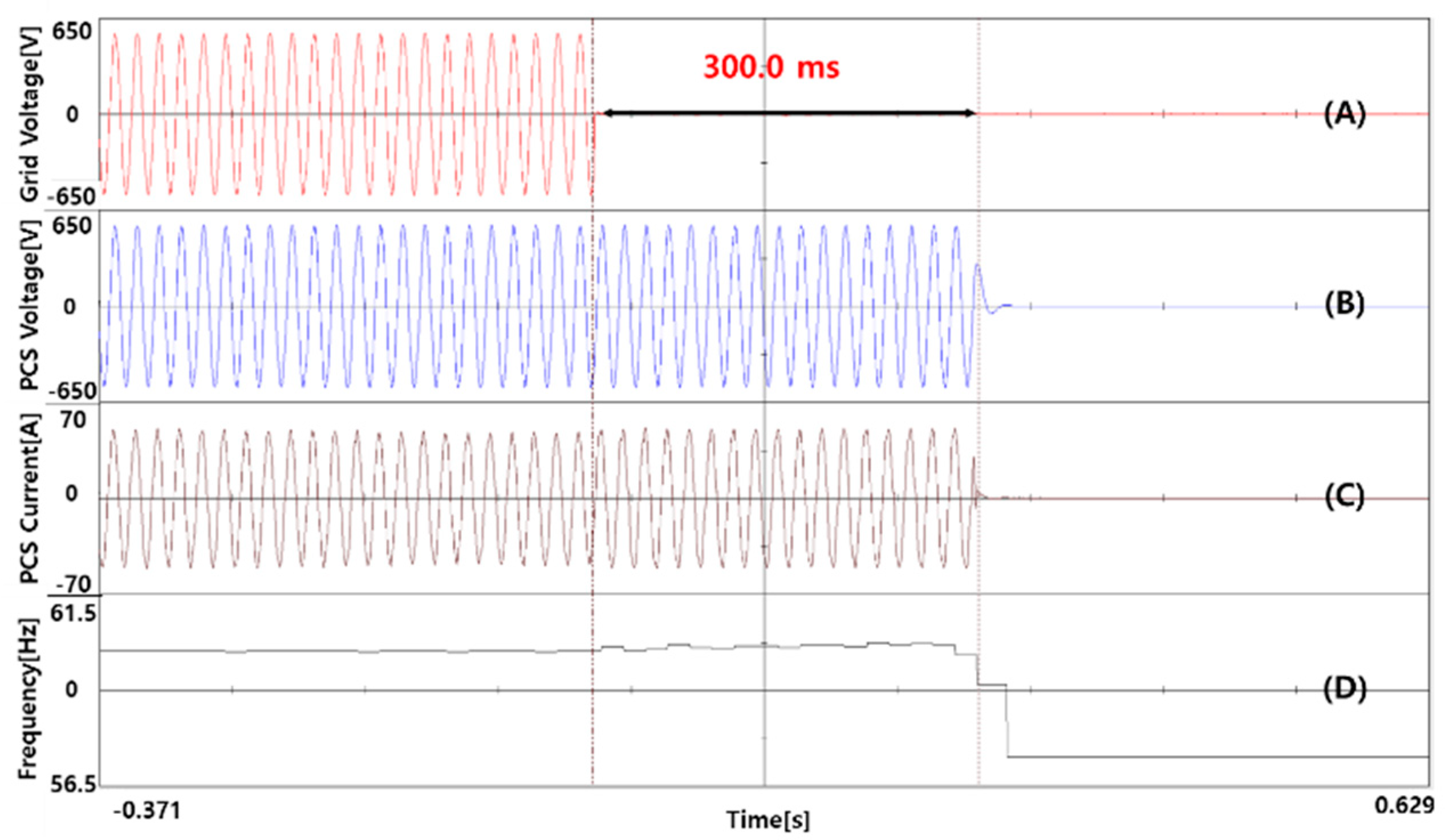


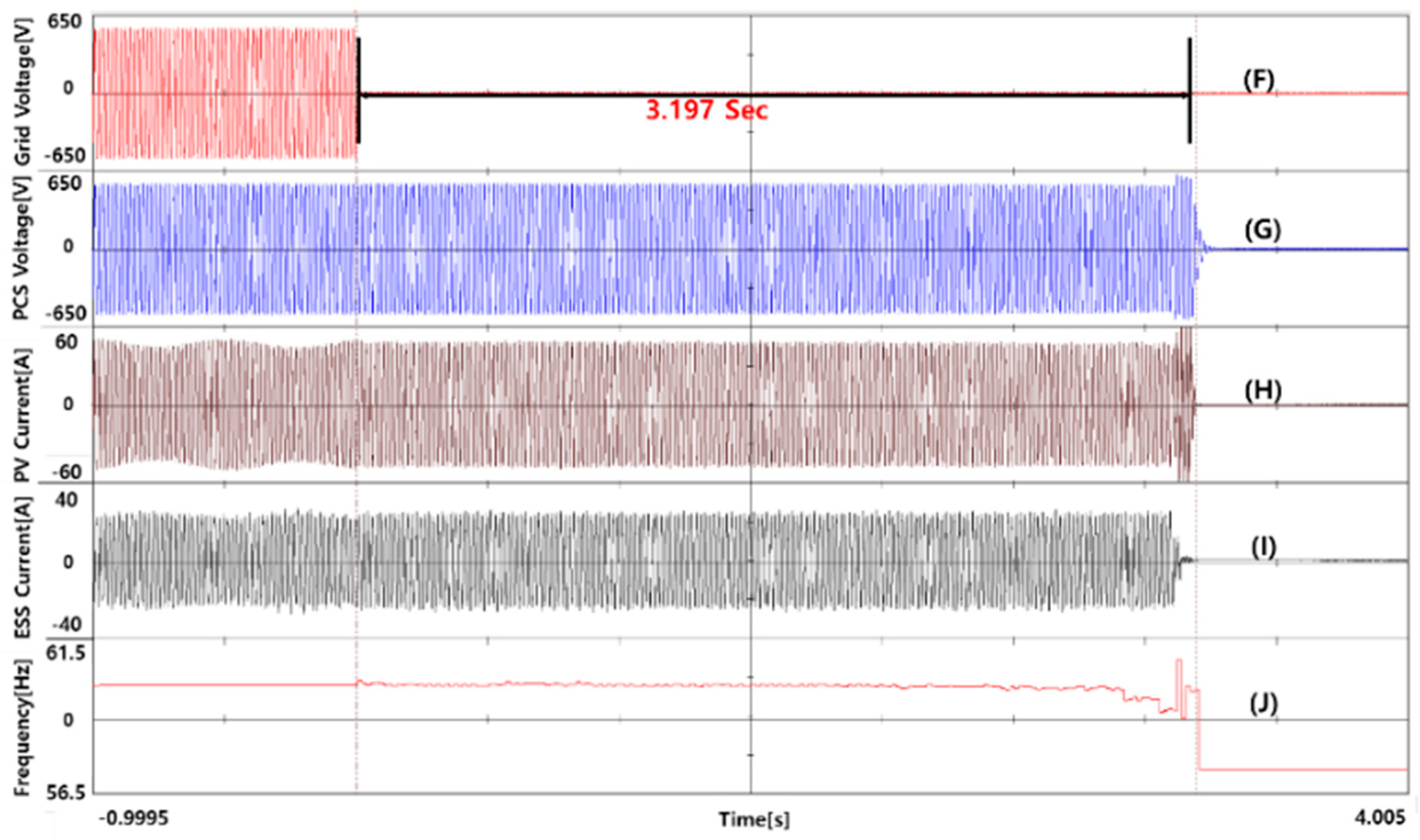
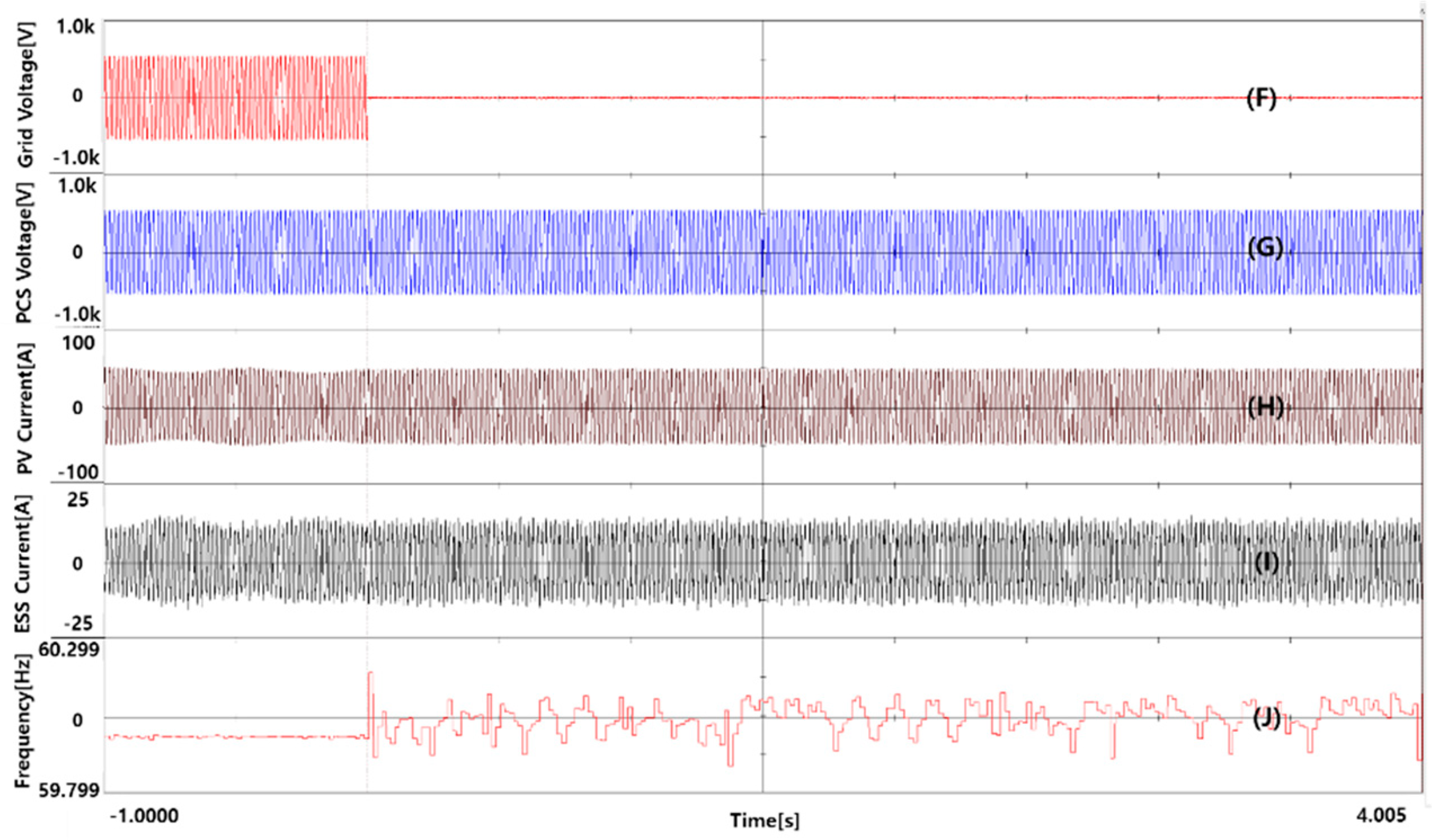
| Division | REC Weighted Value | Installation Type | Detailed Criteria |
|---|---|---|---|
| Only PV System | 1.2 | If you are on regular grounds | Less than 100 kW |
| 1.0 | From 100 kW | ||
| 0.7 | From 3000 kW | ||
| 1.5 | Using existing facilities such as a building | 3000 kW or less | |
| 1.0 | From 3000 kW | ||
| 1.5 | Installing floats on the surface of the retainer | ||
| PV System + EESS | 5.0 | EESS (PV system connection) | ’16, ’17, 18 |
| Quality Factor, Qf | Required Islanding Detection Time, t | Normal Frequency Range, f (Nominal Frequency, f0) | Normal Voltage Range, V (% of Nominal Voltage, V0) | |
|---|---|---|---|---|
| IEEE 62116 | 1 | t < 2 s | ||
| IEEE 1547 | 1 | t < 2 s | ||
| IEEE 929-2000 | 2.5 | t < 2 s | ||
| Japanese standard | 0 (+rotating machinery) | Passive: t < 0.5 s Active: 0.5 s < t < 1 s | Setting Value | Setting Value |
| VDE 0126-1-1 | 2 | |||
| AS4777.3-2005 | 1 | Setting Value | Setting Value |
| Product | A (PV Inverter) | B (EESS Inverter) |
|---|---|---|
| Electrical connection | 3 phase 4 wires | 3 phase 4 wires |
| Nominal power | 20 kW | 50 kW |
| Input/output voltage | Input: 300–600 Vdc Output: 380 Vac | Input: 600–1000 Vdc Output: 380 Vac |
| Isolation type | Transformer type | Transformer-less type |
| Case | Test Conditions | Remarks |
|---|---|---|
| 1 | PV inverter operated at 20 kW, ESS PCS off | RLC load Capacity 20 kW, 20 kVar |
| 2 | PV inverter off, EESS PCS operated at 20 kW in discharging mode | RLC load Capacity 20 kW, 20 kVar |
| 3 | PV inverter operated at 20 kW, EESS inverter operated at 20 kW in discharging mode | RLC load Capacity 40 kW, 40 kVar |
| 4 | PV inverter operated at 20 kW, EESS inverter operated at 20 kW in charging mode | RLC load Capacity 0 kW, 20 kVar |
| 5 | PV inverter operated at 20 kW, EESS inverter operated at 10 kW in charging mode | RLC load Capacity 10 kW, 20 kVar |
| 6 | PV inverter operated at 20 kW, EESS inverter operated at 5 kW in charging mode | RLC load Capacity 15 kW, 20 kVar |
© 2019 by the authors. Licensee MDPI, Basel, Switzerland. This article is an open access article distributed under the terms and conditions of the Creative Commons Attribution (CC BY) license (http://creativecommons.org/licenses/by/4.0/).
Share and Cite
Lim, J.R.; Hwang, H.M.; Shin, W.G.; Song, H.-J.; Ju, Y.-C.; Jung, Y.S.; Kang, G.H.; Ko, S.W. Case Studies for Non-Detection of Islanding by Grid-Connected In-Parallel Photovoltaic and Electrical Energy Storage Systems Inverters. Appl. Sci. 2019, 9, 817. https://doi.org/10.3390/app9050817
Lim JR, Hwang HM, Shin WG, Song H-J, Ju Y-C, Jung YS, Kang GH, Ko SW. Case Studies for Non-Detection of Islanding by Grid-Connected In-Parallel Photovoltaic and Electrical Energy Storage Systems Inverters. Applied Sciences. 2019; 9(5):817. https://doi.org/10.3390/app9050817
Chicago/Turabian StyleLim, Jong Rok, Hye Mi Hwang, Woo Gyun Shin, Hyung-Jun Song, Young-Chul Ju, Young Seok Jung, Gi Hwan Kang, and Suk Whan Ko. 2019. "Case Studies for Non-Detection of Islanding by Grid-Connected In-Parallel Photovoltaic and Electrical Energy Storage Systems Inverters" Applied Sciences 9, no. 5: 817. https://doi.org/10.3390/app9050817




